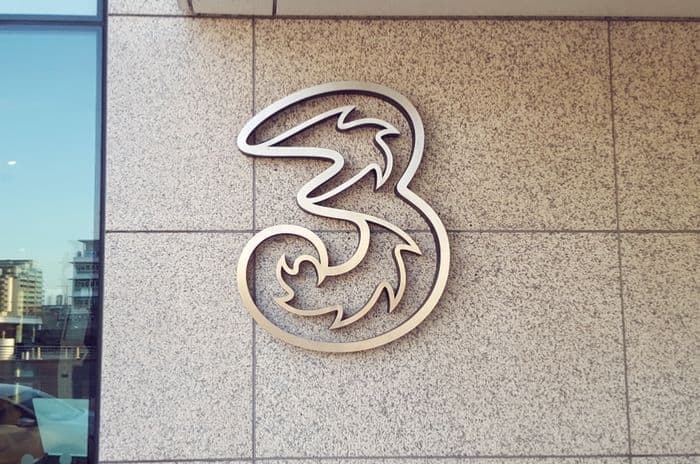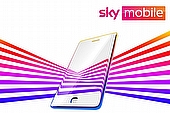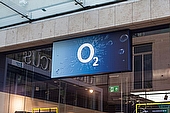
At a glance
| O2 | Three | |
|---|---|---|
| Price of contract | £10 - £30 | £9 - £32 |
| Length of contract | 30 days - 36 months | 30 days - 24 months |
| Speeds | Average 15.4 Mbps | Average 10.5 Mbps |
| Unlimited data? | No - Max 50GB | Yes |
| Coverage (population) | 99% | 99% |
| Customer satisfaction | 92% | 89% |
Special offers
O2 and Three both run special offers from time to time. Here's a quick look at their latest deals.
Call plans
Winner: Three win for both pay as you go and monthly contracts, mainly due to the data allowances available.
O2 and Three offer a full range of pay monthly SIM only deals, pay as you go (PAYG) plans and handsets on contract.
Let's look at those different plans in turn.
Pay monthly
Winner: Three provide more data for lower monthly costs.
Traditional pay monthly SIM deals on a contract are available for 24 months, 12 months or 30 days on both O2 and Three, meaning both offer great flexibility to SIM only customers.
Here are some examples of their 24-month and 12-month deals:
| Package | Minutes | Data | Contract term | Monthly price | ||
|---|---|---|---|---|---|---|
| Three | 4GB data | Unlimited | 4GB | 24 months | £9 | Get deal |
| O2 | 5GB data | Unlimited | 5GB | 24 months | £10 | Get deal |
| Three | 30GB data | Unlimited | 30GB | 24 months | £14 | Get deal |
| O2 | 20GB data | Unlimited | 20GB | 24 months | £15 | Get deal |
| Three | 30GB data | Unlimited | 30GB | 12 months | £15 | Get deal |
| O2 | 20GB data | Unlimited | 20GB | 12 months | £18 | Get deal |
| Three | Unlimited data | Unlimited | Unlimited | 12 months | £20 | Get deal |
| O2 | Unlimited data | Unlimited | Unlimited | 12 months | £33 | Get deal |
While O2 is only slightly more expensive on lower data plans, it's when we get as high as unlimited SIM only deals that Three show markedly better value for money.
Here are some 30-day deals:
| Package | Minutes | Data | Contract term | Monthly price | ||
|---|---|---|---|---|---|---|
| Three | 4GB data | Unlimited | 4GB | 1 month | £16 | Get deal |
| O2 | 3GB data | Unlimited | 3GB | 1 month | £18 | Get deal |
| Three | 30GB data | Unlimited | 30GB | 1 month | £24 | Get deal |
| O2 | 25GB data | Unlimited | 25GB | 1 month | £25 | Get deal |
| Three | Unlimited data | Unlimited | Unlimited | 1 month | £26 | Get deal |
| O2 | Unlimited data | Unlimited | Unlimited | 1 month | £36 | Get deal |
Again, the gap widens as the data plans grow, leaving Three as the undisputed leader when it comes to value for money.
Even the fact that Three have scrapped their popular Go Binge service that zero-rated certain streaming services doesn't seem to matter as much when their unlimited data deals are so cheap in comparison to O2's.
However, something O2 do offer extras and perks that Three simply don't match.
For example, all customers receive daily offers through O2 Priority and those taking longer SIM only and handset contracts will be able to access an Extra for free for up to 12 months.
If it's a service that customers are interested in, this might make up for the extra monthly fees - although watch out to see if it's truly worth it.
Learn more about the facts behind data allowance headlines or check out the cheapest SIM only deals.
Pay as you go
Winner: Three is cheaper and offers higher data allowances.
Both O2 and Three have switched to a pay as you go (PAYG) bundle approach, with O2 confirming back in November 2019 that they were scrapping traditional PAYG.
Instead, customers on both networks now purchase a specific amount of data, minutes and texts at one time and they have access to it for 30 days.
The major difference between the two providers is that O2 allow data to rollover from one month to the next while Three customers will lose whatever they don't use.
Here are their PAYG deals side-by-side:
| Package | Minutes | Data | Contract term | Monthly price | ||
|---|---|---|---|---|---|---|
| Three | 12GB data PAYG | Unlimited | 12GB | PAYG | £10 | Get deal |
| O2 | 7GB data | Unlimited | 7GB | PAYG | £10 | Get deal |
| Three | 30GB data PAYG | Unlimited | 30GB | PAYG | £15 | Get deal |
| O2 | £15 data | Unlimited | 15GB | PAYG | £15 | Get deal |
| Three | 50GB data PAYG | Unlimited | 50GB | PAYG | £20 | Get deal |
| O2 | 30GB data | Unlimited | 30GB | PAYG | £20 | Get deal |
| O2 | 100GB data | Unlimited | 100GB | PAYG | £30 | Get deal |
| Three | Unlimited data PAYG | Unlimited | Unlimited | PAYG | £35 | Get deal |
It's notable that O2 don't offer an unlimited option on PAYG. Plus, their data allowances are lower than Three's at every level, making Three a more economical option for PAYG customers.
Note: O2's £10, £15 and £20 allow a customer's full allowance to be rolled over while the £30 bundle allows rollover of up to 100GB. However, if customers don't renew their pack on the same day the previous one expires, there will be no data rollover.
Roaming
Winner: Three offer inclusive roaming to more countries under their Go Roam Around the World service.
O2 tightened their European roaming rules following Brexit, with customers now able to use a maximum of 25GB for free while roaming.
This is better than EE and Vodafone who have both introduced daily fees for customers to use their phone in Europe.
It's also now better than Three's allowance of 12GB, although that allowance is usable in 71 destinations under their Go Roam Around the World service.
Customers who want to undertake more data-heavy tasks may be better served by a Data Passport at £5 per day, but that isn't obligatory and customers can make do with up to 12GB of roaming data on their normal tariff.
Meanwhile, O2 offer O2 Travel for countries outside the Europe Zone. This costs £4.99 per day for 120 minutes, 120 texts and data.
This is also included as an inclusive bolt-on with some O2 Refresh and SIM only tariffs so keep an eye on the small print in deals if that's an important feature.
Handsets
Winner: Three beats O2 on price most of the time, plus their contract pricing structure is simpler than O2's.
Both O2 and Three offer a range of handsets from the basic models like up to the latest iPhone and Samsung phones.
O2 provide separate costings for handsets, so customers can understand how much they're paying for the device and how much they're paying for airtime every month.
Let's see how O2 and Three compare on three popular handsets with unlimited data:
| Handset | Minutes | Data | Initial price | Monthly price | ||
|---|---|---|---|---|---|---|
| O2 | Apple iPhone 12 (64GB) | Unlimited | Unlimited | £30 | £56.16 24 month term |
Get deal |
| Three | Apple iPhone 12 (64GB) | Unlimited | Unlimited | £49 | £54 24 month term |
Get deal |
| O2 | OnePlus Nord 2 5g (128GB) | Unlimited | Unlimited | £10 | £50.48 24 month term |
Get deal |
| Three | OnePlus Nord 2 5g (128GB) | Unlimited | Unlimited | £19 | £39 24 month term |
Get deal |
| O2 | Oppo Find X3 Neo 5G (256GB) | Unlimited | Unlimited | £20 | £56 24 month term |
Get deal |
| Three | Oppo Find X3 Neo 5G (256GB) | Unlimited | Unlimited | £19 | £45 24 month term |
Get deal |
Note: O2 contracts usually default to 36 months but customers can choose shorter periods if they want to pay more per month or more upfront.
As we can see from the table, Three is slightly cheaper across all our test handsets taking into account their 24-month standard deals.
Special offers will vary from handset to handset, but Three are likely to be slightly cheaper than O2 on most models.
However, price isn't everything, so let's take a closer look at some pivotal issues: coverage and speed.
Coverage
Winner: Tie: it depends which part of the UK we're in and local factors play a role too.
The most recent Ofcom Connected Nations Report for 2020 found that coverage of 4G services continues to improve, with 99% of indoor premises and 91% of geographical locations being served by at least one of the major operators.
Drilling down into that, we can find that the 95% of all indoor premises have access to O2 4G services, while the figure for Three is lower at 90%.
On geographical measures, O2 reach 80% of the UK with their 4G service, while the corresponding figure for Three is 79%.
These figures demonstrate that O2's coverage is better than Three's, yet that doesn't mean that will necessarily be the case in a customer's area as we explain more fully in guide to mobile coverage across the UK.
A quick look at coverage across the four countries of the UK demonstrates what we mean:
So, while O2 have better coverage in Scotland, Three has the edge in Wales and Northern Ireland.
Boosting 4G coverage in rural areas is a high priority for the Government (and, therefore, mobile networks too).
O2 and Three are signed up to the Shared Rural Network (SRN) agreement meaning they will share over 200 new masts to be built by 2024.
This will improve rural coverage for customers of both networks while, individually, they continue to boost their 4G coverage and signal strength at sites across the UK.
5G
Winner: O2 5G is active is more towns and cities.
The 5G rollout hasn't been extensively covered by regulator Ofcom yet, so it's difficult to objectively say which network is doing it better.
O2 say their 5G services are available in parts of 194 towns and cities across the country, while Three's latest update says they have 300 sites in over 100 places.
This distinction is important because Three is upfront about the fact that they have no more than a handful of 5G sites in their 5G areas.
The 5G rollout is going to take time, meaning customers with 5G-capable handsets may enjoy coverage in some busy areas they visit regularly but not in other places where there isn't yet demand for 5G speeds.
For now, 5G coverage may be considered a nice-to-have by customers comparing Three and O2 but not a deal-breaker.
Speeds
Winner: Three are shown in recent research as having faster 4G speeds than O2.
Speed is a key component of a reliable mobile phone service, with both operators competing on 4G and 5G technologies.
If we look at research from Opensignal published in April 2021, we can see the average download and upload speeds experienced by customers are not that different:
| O2 | Three | |
|---|---|---|
| Download Speed Experience | 17.3Mbps | 19.3Mbps |
| Upload Speed Experience | 6.7Mbps | 6.8Mbps |
Data published by RootMetrics looking at the second half of 2020 had a similar story on download speeds:
| O2 | Three | |
|---|---|---|
| UK-wide speeds | 12.9Mbps | 13.9Mbps |
Both of these reports show Three slightly ahead on download speed, something that goes against the popular opinion that Three is the slower network.
On a nation-by-nation analysis, the RootMetrics research shows Three ahead in Scotland, Wales and England:
| O2 | Three | |
|---|---|---|
| Scotland | 11.5Mbps | 13.4Mbps |
| Northern Ireland | 12.4Mbps | 11.0Mbps |
| Wales | 7.0Mbps | 11.6Mbps |
| England | 13.3Mbps | 14.1Mbps |
So, in most cases, Three is going to be the faster network, yet most customers probably won't notice the slight uptick in speeds and, as we've pointed out above, coverage plays a big part in this too.
Data on 5G speeds from RootMetrics shows that both networks are improving their speeds. RootMetrics test signal in 16 major cities, so the data shouldn't be taken too far out of context, but it's a good show of progress.
Here are some comparisons between H1 2021 and H2 2020:
| O2 | Three | |
|---|---|---|
| Cities with median 5G speeds over 150Mbps | 6 | 0 |
| Cities with median 5G speeds between 100Mbps and 150Mbps | 10 | 6 |
| Cities with median 5G speeds between 50Mbps and 100Mbps | 0 | 10 |
From this research, then, it looks as though O2's 5G is now delivering consistently higher speeds than Three's, albeit only in a handful of test cities so far.
Customer service
Winner: O2 has a better customer service record than Three.
With some of our comparisons, customer service is where the differences really start to show and it's O2 who have the edge in this battle.
These are figures from Ofcom's most recent Comparing Service Report:
| O2 | Three | Industry Average | |
|---|---|---|---|
| Satisfaction with Overall Service | 91% | 86% | 90% |
| Satisfaction with Value for Money | 79% | 88% | 83% |
| Call Waiting Time | 2m 17s | 1m 3s | 2m 7s |
| Customers with a Reason to Complain | 7% | 13% | 10% |
| Complaints per 100,000 Customers | 8 | 23 | 13 |
| Satisfaction with Complaint Handling | 62% | 56% | 57% |
O2 posts scores better than the industry average in several key areas including overall satisfaction and satisfaction with complaints handling.
Three answered the phone a little quicker, however, and far more customers thought they represented good value for money.
On balance, though, if customer service is a crucial consideration, O2 nudge Three out of the way to triumph.
Verdict: Who is best O2 vs Three?
Overall winner: Three have the edge, even though O2 beat them on some points.
If data value on the top handsets and on SIM only deals is important, Three win. Their pay monthly plans, PAYG tariffs and handset deals are cheaper than O2's and offer higher data allowances too.
In terms of coverage and 4G speeds, Three also win this battle, although O2 are showing faster progress on 5G services.
O2 start to shine when we think of them as more of a premium mobile network.
For example, they offer an Extra to many customers and automatic access to O2 Priority for special deals too. In addition, their customer service metrics are better than Three's, with far fewer O2 customers saying they have a reason to complain about their mobile service.
Ultimately, it might come down to which network has a special deal on the handset a customer is looking at. When using the free Choose tool to compare mobile deals, sort by special offers to see the best deals available from each network.









Comments